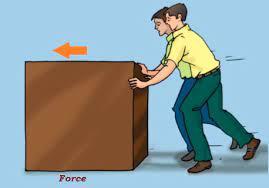There are numerous verbs that can be used to express the various actions involved in completing a certain activity. Every single one of these operations alters the object's motion in some way. Is it possible to substitute one or more of these terms? Let's know more:

Source: https://byjus.com/cbse-notes/cbse-class-8-science-notes-chapter-11-force-and-pressure/
Forces exist as a result of an interaction:
A man is standing next to a parked automobile. What will happen if he gets in the car? If the man now starts pushing the car, he is exerting force on it. When a force is applied to the car, it may begin to move in that direction. The man had to push the car in order to get it going. As a result, we can conclude that the existence of a force is contingent upon the interaction of at least two things. As a result, when two items come into contact with each other, they generate a force.
Examining Forces of Nature:
An object's mass is increased by applying forces in the same direction. It is the difference between the two forces that acts on an object, if the two forces are acting in different directions. A force can be stronger or smaller than the other, as well as equal to one another. The magnitude of a force is often used as a measure of its power. In addition, the force's direction must be specified. Changing the amplitude or direction of the applied forces can also alter the result.
The state of motion can be altered by an external force:
Taking a penalty kick in football, for example, requires the player to exert force on the ball. The ball was at rest before it was hit, and as a result, its speed was 0 mph. When a force is applied, the ball moves in a specific direction toward the goal. For example, let us imagine that the goalkeeper is attempting a diving or leaping save. The goalkeeper tries to exert some kind of force on the ball through his actions. He can stop or deflect the ball and prevent a goal from being scored with the force he uses. The ball's speed drops to 0 if the goalkeeper stops it.
These findings suggest that an object's speed may be affected by a force applied to it. The object's speed rises when a force is applied to it in the direction it is moving. The object's speed decreases if the force is applied in the opposite direction of the object's motion.
- Let's look at a few more real-world instances. Volleyball players frequently pass the ball to their teammates in order to score points. To get the ball back to the other end of the court, players may push or smash it.
- A cricket hitter hits the ball with his or her bat to perform a shot. Are there any circumstances where the ball's motion is altered? All of these examples show how the speed and direction of a moving ball can alter when a force is applied.
- State of motion is a term used to describe a change in the speed or direction of motion of an object. Thus, an object's state of motion can be altered by a force.
- Is it a given that the object's state of motion would change as a result of the application of a force? Most people know that a lot of time, applying force does not influence the object's movement. Even if you exert your full force on a heavy box, it may not move at all. When you try to push against a wall, there is no noticeable result of force.

Source: https://www.tutorialspoint.com/physics_part1/physics_force_and_pressure.htm
 Maths (16)
Maths (16)